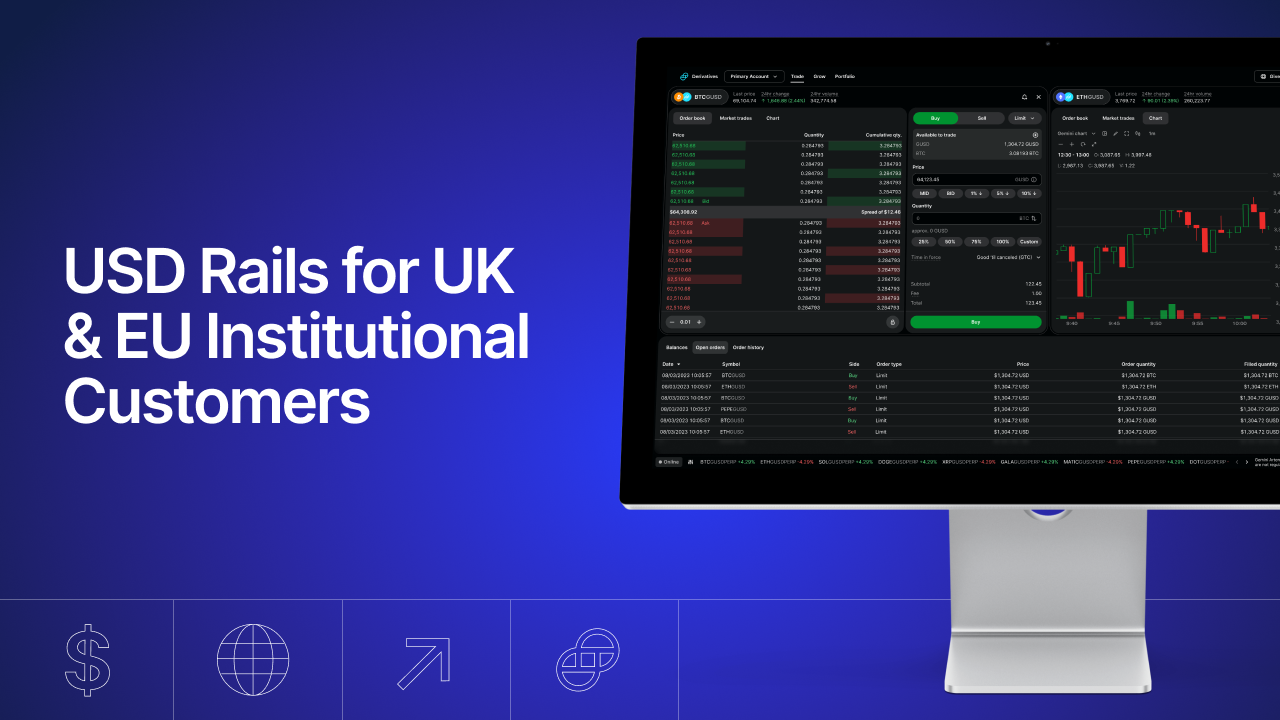Blog home
WEEKLY MARKET UPDATE
MAY 19, 2023
Weekly Market Update - Friday, May 19, 2023

Welcome to our Weekly Market Update.* Explore weekly crypto price movements, read a quick digest of notable market news, and dive into a crypto topic — this week we discuss perpetual futures contracts in crypto.
Crypto Movers
Crypto News: What Happened This Week?
Crypto Topic of the Week: Perpetual Futures Contracts

Bitcoin (BTC) Price | ⬆️ 2.13% | $26,896
Ether (ETH) Price | ⬆️ 2.94% | $1,816
Render (RNDR) Price | ⬆️ 39.20% | $2.384
Pepe (PEPE) Price | ⬆️ 28.00% | $0.000001513
Mask (MASK) Price | ⬆️ 26.10% | $4.531
Crypto prices as of Friday, May 19, 2023, at 11:55am ET. Percentages reflect trends over the past seven days. Check out the latest crypto prices here. All prices in USD.

Takeaways
- U.S. stocks gained this week as optimism grew around a potential deal to raise the debt ceiling. Without a deal, the U.S could default on its $31.4 trillion USD debt as soon as June 1. On Friday, however, it was reported that debt ceiling talks had broken down.
- Bitcoin 2023, the world's premier Bitcoin conference, is taking place this week as BTC has been trying to nudge higher. After hitting recent lows, both BTC and ETH have struggled to regain momentum.
- GALA performed well this week following its v2 upgrade, and LTC rose with its next halving event expected in August.
- Tether, the largest stablecoin issuer, announced that it would begin investing up to 15% of its net profit into BTC, in a bid to diversify its reserve backing.
U.S. Markets Rise on Debt Ceiling Deal Optimism
U.S. stock market indices rose this week on the back of increased optimism that President Joe Biden and congressional leaders have made progress and are moving closer to securing a deal to raise the U.S debt ceiling. House Speaker Kevin McCarthy suggested that a deal could be agreed to before the end of the week, with Biden cutting short a trip to Asia in an effort to prioritize the negotiations. On Friday, however, it was reported that debt ceiling talks had broken down.
Without a deal, the U.S could enter a default on its $31.4 trillion USD debt as soon as June 1, which could have detrimental effects on the markets and global financial system.
Investors' expectations regarding the next Federal Open Market Committee (FOMC) meeting in June have shifted throughout the week, following U.S. central bankers signaling that they see interest rates remaining high or moving even higher given the rate at which inflation is slowing. The market is now pricing in a ~33% chance that the Fed will increase rates at the June 14th meeting, up from 10% a week earlier.
BTC and ETH Recover From Recent Lows, But Remain Depressed
Bitcoin 2023, the world's premier Bitcoin conference, is taking place this week as the bitcoin (BTC) price has been trying to nudge higher. After dropping to a two-month low around $26k USD last Friday, the price has somewhat recovered and made various unsuccessful attempts to break above the $27.5k USD resistance. Similarly, ether (ETH) recovered from its low of $1,737 last Friday, trading around the $1,800 USD mark throughout the week.
GALA Sees Price Boost Following v2 Upgrade
Gala Games (GALA) completed its Version 2 upgrade this week along with an airdrop for all GALA Version 1 holders. The GALA v2 airdrop resulted in v1 holders receiving a 1:1 airdrop of the v2 token.
Gala also announced that it has burned ~21 billion GALA tokens (~$650m USD) following the v2 airdrop. They first burned 2 billion tokens which was outlined in their 2023 Vision Paper, with another 4 billion tokens being burned which “was equivalent to the total revenue in GALA we have ever received.” A further 15 billion tokens were burned, which was reported to represent “nearly the entirety of our reserves.”
These burns represented a huge proportion of the token’s maximum supply which previously was 50 billion, and were done to eliminate concerns of a potential “dump and exit scenario.” Following the news, GALA is currently trading up ~9% over the past seven days.
Tether Buys More Than $200m USD of BTC to Back USDT
On Wednesday, the largest stablecoin issuer, Tether (USDT), announced that it would begin investing up to 15% of its net profit into BTC, in a bid to diversify the reserves backing the stablecoin. Based on its most recent first quarter attestation report, that would be over $200m worth of Bitcoin and would add to the $1.5b USD worth of BTC the company already holds on its balance sheet.
Litecoin (LTC) Rallies With Next Halving Event Expected in August
Litecoin (LTC) performed well this week, with traders potentially eyeing up the next halving event which is set to take place in August. LTC went on an impressive run gaining ~18% over the past seven days.
On August 2nd, block rewards will be cut from 12.5 LTC to 6.25 LTC. The launch of the LTC Ordinals Protocol (LTC-20) token standard on May 1st could also be a catalyst for renewed interest in LTC, with Litecoin Daily Active Addresses spiking by over 200% in May.
-From the Gemini Trading Desk

Perpetual Futures Contracts in Crypto
Many of the financial derivative products present in traditional financial markets have made their way over to the crypto ecosystem, offering crypto traders the ability to develop more sophisticated trading strategies. Today, we provide a high-level overview of one type of derivative, perpetual futures contracts or perps.
What are perps?
Before diving into the specific characteristics of perps, we must first understand futures contracts, or futures. A future is a derivative instrument whose value is tied to another underlying asset. In crypto, the underlying asset is a token like BTC. As the value of BTC goes up, so does the value of the BTC future. If you buy a BTC future, you profit when BTC goes up. Similarly, if you short sell a BTC future, you profit when BTC goes down.
Learn more about crypto derivatives here.
There are two types of futures: dated and perpetual (perp). The major difference is that dated futures have an expiration date. When an expiration date is reached, trader profits and losses are realized and settled. Perps, on the other hand, never expire and therefore profits and losses are only realized after the position is closed.
Why trade a perp rather than the asset itself?
If the value of a perp is tied to the value of the underlying asset, why not just trade the asset? There are several reasons traders decide to trade perps, which mostly have to do with characteristics of perps that generally do not exist with spot.
- Shorting — In the spot market, the choices a trader has are generally to hold an asset or not hold an asset. There isn’t a readily available mechanism to directly bet against a crypto asset. With perps, you can take a short position, effectively betting against an asset to profit when the price falls.
- Leverage — With spot, if the price of the asset goes up 10%, the value of the position also goes up 10%. When trading perps, a trader can use leverage, which has a multiplier effect on gains and losses, sometimes as high as 100x or 125x. Leverage enables traders to take larger positions without investing more capital. This is often known as trading on margin.
- Never holding the asset — Most crypto perps contracts are denominated and settled in a stablecoin, meaning you never have to hold the underlying asset in your margin account to trade the corresponding perp. This is especially beneficial if you trade several different perps (BTC, ETH, SOL, etc.) because you only need to hold one stablecoin in your margin account, rather than each crypto.
How are perps typically used?
There are multiple reasons to trade perps, we’ll touch on a few of them here:
- Speculation — the most obvious use of perps is to make a directional bet on the price of an asset. For the benefits stated above, perps can allow an investor to efficiently manage the direction and size their position.
- Hedging — if a trader is holding an asset but wants to be insulated from the risk of the asset going down (hedged), they can offset their holding by taking a short position in the perp without having to sell the asset outright.
- Trading strategies — The flexibility and structure of perps makes them ideal for a variety of trading strategies. One example is basis trading, where a trader effectively arbitrages price differences between spot, perps, dated futures or even similar instruments on different exchanges.
See you next week. Onward and Upward!
Team Gemini
*This material is for informational purposes only and is not (i) an offer, or solicitation of an offer, to invest in, or to buy or sell, any interests or shares, or to participate in any investment or trading strategy, (ii) intended to provide accounting, legal, or tax advice, or investment recommendations, or (iii) an official statement of Gemini. Gemini, its affiliates and its employees do not make any representation or warranty, expressed or implied, as to accuracy or completeness of the information or any other information transmitted or made available. Buying, selling, and trading cryptocurrency involves risks, including the risk of losing all of the invested amount. Recipients should consult their advisors before making any investment decision. Any use, review, retransmission, distribution, or reproduction of these materials, in whole or in part, is strictly prohibited in any form without the express written approval of Gemini.
RELATED ARTICLES

WEEKLY MARKET UPDATE
MAR 13, 2025
Recession Fears Weigh Down Crypto Market, Mt. Gox Moves ~$1B, and El Salvador Builds Up Bitcoin Reserve

COMPANY
MAR 12, 2025
Gemini To Set Guinness World Record With Largest Bitcoin Drone Show

COMPANY
MAR 12, 2025